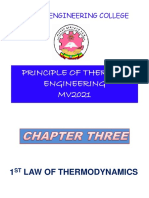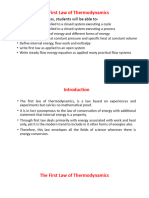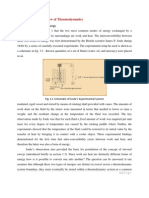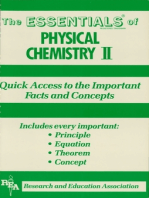CCTD101B Notes 4 - 1st Law of Thermodynamics
CCTD101B Notes 4 - 1st Law of Thermodynamics
Uploaded by
Shan ShanzCopyright:
Available Formats
CCTD101B Notes 4 - 1st Law of Thermodynamics
CCTD101B Notes 4 - 1st Law of Thermodynamics
Uploaded by
Shan ShanzOriginal Title
Copyright
Available Formats
Share this document
Did you find this document useful?
Is this content inappropriate?
Copyright:
Available Formats
CCTD101B Notes 4 - 1st Law of Thermodynamics
CCTD101B Notes 4 - 1st Law of Thermodynamics
Uploaded by
Shan ShanzCopyright:
Available Formats
UNIVERSITY OF TRINIDAD AND TOBAGO
B.A.Sc. Utilities Engineering
February 02, 2009
CCTD101B Engineering Thermodynamics (Lecture Notes 4)
The First Law of Thermodynamics
4. First Law of Thermodynamics.............................................................................................................1
4.1 Energy Balance for Closed Systems.............................................................................................1
4.2 Nature of Stored Energy................................................................................................................1
4.3 First Law Applied to Cyclic Processes.........................................................................................4
4.4 Power Cycles.................................................................................................................................4
4.5 Refrigeration and Heat Pump Cycle.............................................................................................5
4.5.1 Refrigeration Cycles..............................................................................................................5
4.5.2 Heat Pump Cycles..................................................................................................................6
4.6 The First Law Applied to Open Systems......................................................................................6
4. First Law of Thermodynamics
4.1 Energy Balance for Closed Systems
The only ways the energy of a closed system can be changed are through transfer of energy by work or
by heat. Further, based on the experiments by Joule and others, a fundamental aspect of the energy
concept is that energy is conserved; we call this the first law of thermodynamics. These considerations
are summarized in words as follows:
][ ][ ]
net amount of energy net amount of energy
[
changethe amount
transferred across transferred out across
of energy contained =
the systembounda ry by the system boundary by
the system during
heat transfer during the work during the
some time interval
timeinterval time interval
This word statement is just an accounting balance for energy and represents the Principle of
Conservation of Energy.
The energy balance can be expressed in symbols as:
E2E 1=QW
4.2 Nature of Stored Energy
Energy can be stored in many forms such as potential, kinetic, electrical, magnetic, surface and other
energies:
Potential energy is the energy stored in a system as a result of its location in a gravitational field, and its
magnitude is given by PE = mgz
CCTD101B The First Law of Thermodynamics 1
Kinetic energy is the energy stored in a system by virtue of the motion of the system, and its magnitude
mV 2
KE
is given by: 2 .
Internal energy U is the form of energy stored in a system that is independent of gravity, motion,
electricity, magnetism and surface tension. The internal energy is related to the PE and KE of the
molecules of the substance and to the internal structure of the molecules. In the absence of motion,
gravity, electricity, magnetism and surface tension, U = E. If motion and gravity are considered;
mV 2
E U mgz
2
Introducing these types of energy, the energy balance can be alternatively written as:
KE+ PE+ U =QW
For closed systems, the effects of gravity and motion are negligible. Ignoring the effects of electric,
magnetic, solid distortion and surface tension, the first law applied to a closed system becomes:
U =QW
In analyzing systems, it is important to recognize that the location of system boundary can be relevant in
determining whether a particular energy transfer is regarded as heat or work.
For example, consider the figure below, in which three alternative systems are shown that include a
quantity of gas (or liquid) in a rigid, well insulated container. In figure (a) the gas itself is the system. As
current flows through the copper plate, there is an energy transfer from the copper plate to the gas. Since
this energy transfer occurs as a result of the temperature difference between the plate and the gas, it is
classified as a heat transfer. Next refer to figure (b) where the boundary is drawn to include the copper
plate. It follows from the thermodynamic definition of work that the energy transfer that occurs as
current crosses the boundary of this system must be regarded as work. Finally, in figure (c) the boundary
is located so that no energy is transferred across it by heat or work.
CCTD101B The First Law of Thermodynamics 2
Example
4 kg of a certain gas is contained within a piston-cylinder assembly. The gas undergoes a process for which the pressure
volume relationship is
pV 1.5=constant
The initial pressure is 3 bar, the initial volume is 0.1 m 3, and the final volume is 0.2 m 3. The change in specific internal
energy in the process is u2u1 =4.6 kJ /kg . There are no significant changes in kinetic and potential energy.
Determine the net heat transfer for the process in kJ.
CCTD101B The First Law of Thermodynamics 3
4.3 First Law Applied to Cyclic Processes
The energy balance for any system undergoing a thermodynamic cycle takes the form
E cycle=QcycleW cycle
where Qcycle and Wcycle represent net amounts of energy transfer by heat and work for the cycle. Since the
system is returned to its original state after the cycle, there is no net change in energy. Therefore the
equation reduce to
Qcycle=W cycle
This equation is an expression of the conservation of energy principle that must be satisfied by every
thermodynamic cycle regardless of the sequence of processes followed by the system undergoing the
cycle or the nature of the substances making up the system.
The diagram below provides simplified schematics of two general classes of cycles; power cycles and
refrigeration and heat pump cycles. In each case a system undergoes a cycle while communicating
thermally with two bodies, one hot and the other cold. These bodies are systems located in the
surroundings of the system undergoing the cycle. During each cycle there is also a net amount of energy
exchanged with the surroundings by work.
4.4 Power Cycles
Systems undergoing cycles of the type shown in figure (a) above deliver a net work transfer of energy to
the surroundings during each cycle. Any such cycle is called a power cycle. From the first law equation
for a cycle:
W cycle =QQ out
Where Qin represents the heat transfer of energy into the system from the hot body and Qout represents
heat transfer out of the system to the cold body. From this equation, it is clear that Qin must be greater
than Qout for a power cycle. The energy supplied by energy transfer to a system undergoing a power
cycle is normally derived from fuel combustion. The energy Qout is normally discharged to the
surrounding atmosphere or a nearby body of water.
CCTD101B The First Law of Thermodynamics 4
The performance of a system undergoing a power cycle can be described in terms of the extent to which
the energy added by heat Qin is converted to a net work output, Wcycle. The extent of the energy
conversion form heat to work is called the thermal efficiency,
W
= cycle
Q
Introducing the power cycle equation:
Q Qout Q
= =1
Q Qout
Since energy is conserved, it follows that thermal efficiency can never be greater than unity (100%).
Experience with actual power cycles show that the value of the thermal efficiency is invariable less than
unity due to heat rejection to the cold body. All the heat supplied cannot be converted into work.
4.5 Refrigeration and Heat Pump Cycle
A refrigeration and heat pump cycle is shown in figure (b) above. For cycles of this type, Qin is the
energy transferred by heat into the system undergoing the cycle from the cold body, and Qout, is the
energy discharged by heat transfer from the system to the hot body. To accomplish these energy transfers
requires a net work input Wcycle. The quantities Qin, Qout, and Wcycle are related by the energy balance and
which for refrigeration and heat pump cycles take the form
W cycle =Qout Q
Since Wcycle is positive in this equation, it follows that Qout is greater than Q .
Refrigeration and heat pump cycles have different objectives. The objective of a refrigeration cycle is to
cool a refrigerated space or maintain the temperature within a dwelling below that of the surroundings.
The objective of a heat pump is to maintain the temperature within a dwelling or other building above
that of the surroundings or provide heating for certain industrial processes that occur at elevated
temperatures.
Since refrigeration and heat pump cycles have different objectives, their performance parameters called
coefficient of performances are defined differently.
4.5.1 Refrigeration Cycles
The performance of a refrigeration cycle can be described as the ratio of the amount of energy received
by the system undergoing the cycle from the cold body, Q to the net work into the system to
accomplish this effect Wcycle. Thus the coefficient of performance, , is
Q
=
W cycle
Introducing the energy balance equation above, an alternative expression for is
Q
=
Qout Q
CCTD101B The First Law of Thermodynamics 5
4.5.2 Heat Pump Cycles
The performance of heat pumps can be described as the ratio of the amount of energy discharged from
the system undergoing the cycle to the hot body, Qout to the net work into the system to accomplish
this effect Wcycle. Thus the coefficient of performance, is
Q
= out
W cycle
Introducing the energy balance equation above, an alternative expression for is
Qout
=
Qout Q
4.6 The First Law Applied to Open Systems
For open systems, the general statement of the first law is
(Net Increase in stored energy of system) = (net amount of energy added to system as heat and all forms of work)
+ (stored energy of matter entering system)
(stored energy of matter leaving system)
Whenever matter crosses the boundary of a system, work is done on or by the system. Therefore, the
total work for an open system is usually separated into two parts: (1) the work required to push a fluid in
or out of the system, called flow work, and (2) all other forms of work. At any section where matter
crosses a system boundary the flow work per unit mass is
flow work per unit mass = pv
Flow work does not apply a force to a moving system boundary or a torque to a rotating shaft, so it is
treated separately from all other kinds of work. Therefore the symbol W means all work other than flow
work, and the energy balance for an open system can be formulated as
dE
Q W m (e pv) m (e pv )
dt inlets outlets
dE dU
For a simple compressible fluid, (Sub. dt dt if open system itself is at rest and e = u + V2/2 + gz)
dU V2 V2
Q W m (ui pi vi i gzi ) m(u e pe ve e gz e )
dt 2 2
or using enthalpy, which is defined as h = u + pv
dU V2 V2
Q W m (hi i gz i ) m(he e gz e )
dt 2 2
For an open system, steady flow (all properties at each section remain constant with respect with time)
V 2 Vi 2 g z z
q w (he hi ) e e i
2
This is the most frequently used form of the first law equation for steady flow systems because many
steady flow systems have only one inlet and one outlet, one dimensional flow is a common assumption
and effects of electricity, magnetism and surface tension are negligible.
CCTD101B The First Law of Thermodynamics 6
oooOooo
CCTD101B The First Law of Thermodynamics 7
You might also like
- CNTR 405 Module 2pDocument28 pagesCNTR 405 Module 2pygr2ndkmq5No ratings yet
- Lecture 3 ThermodynamicsDocument54 pagesLecture 3 Thermodynamicstorawe6575No ratings yet
- 002general Energy Analysis of THERMODYNAMICSDocument30 pages002general Energy Analysis of THERMODYNAMICSm7sen mohammedNo ratings yet
- First Law of Thermodynamics For A Control MassDocument51 pagesFirst Law of Thermodynamics For A Control MassTushyNo ratings yet
- Chap 2 BDocument18 pagesChap 2 BMike BelayNo ratings yet
- Chapter 02 Energy, Energy Transfer, and General Energy AnalysisDocument42 pagesChapter 02 Energy, Energy Transfer, and General Energy Analysislassi19aNo ratings yet
- Thermodynamics 1 - Energy, Energy Transfer, and General Energy AnalysisDocument21 pagesThermodynamics 1 - Energy, Energy Transfer, and General Energy AnalysisFlorasaurus17100% (1)
- Chapter Three First Law of Thermodynamics: Fig. 3-1 Cyclic ProcessDocument9 pagesChapter Three First Law of Thermodynamics: Fig. 3-1 Cyclic ProcessEnenamahNo ratings yet
- Chapter - 2 For e ClassDocument25 pagesChapter - 2 For e Classparsa.shakeri.bavilNo ratings yet
- The First Law of Thermodynamics: Openstax CollegeDocument11 pagesThe First Law of Thermodynamics: Openstax CollegeVirginia FernandezNo ratings yet
- 3 Thermo I Chapter 3 Lec2Document51 pages3 Thermo I Chapter 3 Lec2tarikus893No ratings yet
- Chapter 4 First Law1Document74 pagesChapter 4 First Law1Mihir Kumar MechNo ratings yet
- L2 (Energy Analysis)Document31 pagesL2 (Energy Analysis)Kavin KabilanNo ratings yet
- Thermal FluidDocument19 pagesThermal FluidOsama F. AnabtawiNo ratings yet
- File 1544349402Document13 pagesFile 1544349402Adeline Nkwekeu VasongiNo ratings yet
- Chapter 5Document15 pagesChapter 5Muneeb BhaniaNo ratings yet
- Lec 04Document6 pagesLec 04MesipNo ratings yet
- Solution Manual ThermodynamicsDocument0 pagesSolution Manual ThermodynamicsVigna Ruban Ram100% (1)
- Second Law of Thermodynamics Week - 4 - : Dastan KhalidDocument24 pagesSecond Law of Thermodynamics Week - 4 - : Dastan Khalidaya khazrajiNo ratings yet
- First LawDocument26 pagesFirst Lawsifat2102146No ratings yet
- First Law of Thermodynamics: Cycle CycleDocument32 pagesFirst Law of Thermodynamics: Cycle CycleT Hari PrasadNo ratings yet
- CH 2Document46 pagesCH 2جلال بولادNo ratings yet
- First Law of ThermodynamicsDocument55 pagesFirst Law of ThermodynamicsMahadi HasanNo ratings yet
- Defence Engineering College: Thermodynamics MV2011Document48 pagesDefence Engineering College: Thermodynamics MV2011Getachew TikueNo ratings yet
- Bab 2Document18 pagesBab 2Muhamad Ghufron MusyafaNo ratings yet
- Principle of Thermal Engineering-3Document51 pagesPrinciple of Thermal Engineering-3Getachew TikueNo ratings yet
- Chapter 4Document46 pagesChapter 4CerealkillerNo ratings yet
- ch1 PDFDocument26 pagesch1 PDFDono SusilNo ratings yet
- Solution 2.2: CHAPTER 2. The First Law and Other Basic ConceptsDocument8 pagesSolution 2.2: CHAPTER 2. The First Law and Other Basic ConceptsFelix LauwentoNo ratings yet
- Week 7 2014Document21 pagesWeek 7 2014Nicole Anne BorromeoNo ratings yet
- The First Law of Thermodynamics-2Document64 pagesThe First Law of Thermodynamics-2Sayan MondalNo ratings yet
- Lecture 2 Energy, Energy Transfer, and General Energy Analysis PDFDocument41 pagesLecture 2 Energy, Energy Transfer, and General Energy Analysis PDFChiang LeeNo ratings yet
- Chapter 1 - Introduction: Cengel Florio 14FDocument29 pagesChapter 1 - Introduction: Cengel Florio 14Fs73a1thNo ratings yet
- The First Law - CH 2 Atkins - 9th - EdDocument119 pagesThe First Law - CH 2 Atkins - 9th - EdAdelia Ayu WandiraNo ratings yet
- Part 2 Energy Equations 094651Document22 pagesPart 2 Energy Equations 094651CedricNo ratings yet
- Chemical Engineering ThermodynamicsDocument11 pagesChemical Engineering ThermodynamicsP P DNo ratings yet
- Lecture # 03Document7 pagesLecture # 03Zafarullah HakroNo ratings yet
- Unit IV ThermodynamicsDocument7 pagesUnit IV ThermodynamicsAyush KatiyarNo ratings yet
- Chapter 1 Lecture Notes For Thermodynamics: An Engineering Approach, 3 Ed by Cengel and BolesDocument22 pagesChapter 1 Lecture Notes For Thermodynamics: An Engineering Approach, 3 Ed by Cengel and Bolessam_kamali85100% (1)
- Second Law of Thermodynamics Alternative StatementsDocument42 pagesSecond Law of Thermodynamics Alternative StatementsGabriel CisnerosNo ratings yet
- Chapter Four, FLOTDDocument74 pagesChapter Four, FLOTDIyasu taresaNo ratings yet
- ME 2801 2 First Law of ThermodynamicsDocument79 pagesME 2801 2 First Law of ThermodynamicsRamjan Ali SiamNo ratings yet
- Aula 6Document57 pagesAula 6JehuNo ratings yet
- Fundamentals HVACDocument183 pagesFundamentals HVACbookslover1No ratings yet
- (Ebook) Fundamentals HvacDocument183 pages(Ebook) Fundamentals HvacRene VillaNo ratings yet
- Energy, Work and Heat: (Tenaga, Kerja & Haba)Document63 pagesEnergy, Work and Heat: (Tenaga, Kerja & Haba)Shafiq HafizullahNo ratings yet
- Lecture 6Document24 pagesLecture 6mazen mohamedNo ratings yet
- CHAPTER 3: First Law of Thermodynamics: 3.1 Concept of Internal EnergyDocument18 pagesCHAPTER 3: First Law of Thermodynamics: 3.1 Concept of Internal EnergyMangesh UgrankarNo ratings yet
- New Microsoft PowerPoint PresentationDocument18 pagesNew Microsoft PowerPoint PresentationLokesh BaviskarNo ratings yet
- Energy Balance - Part IDocument16 pagesEnergy Balance - Part I랄뚜기No ratings yet
- Q & A - Basic ThermoDocument32 pagesQ & A - Basic ThermoManoranjan Kumar SinghNo ratings yet
- Applied Thermodynamic NotesDocument83 pagesApplied Thermodynamic NotesMukesh KumarNo ratings yet
- Me265 Mai TH 2Document19 pagesMe265 Mai TH 2Fahimul Haque ProttayNo ratings yet
- “Foundations to Flight: Mastering Physics from Curiosity to Confidence: Cipher 4”: “Foundations to Flight: Mastering Physics from Curiosity to Confidence, #4From Everand“Foundations to Flight: Mastering Physics from Curiosity to Confidence: Cipher 4”: “Foundations to Flight: Mastering Physics from Curiosity to Confidence, #4Rating: 5 out of 5 stars5/5 (1)
- A Modern Course in Statistical PhysicsFrom EverandA Modern Course in Statistical PhysicsRating: 3.5 out of 5 stars3.5/5 (2)



























































